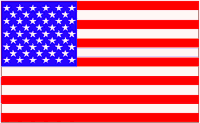|
A Brief History of the American Flag
Like America itself, the flag has evolved
significantly since its birth more than two hundred years ago.
The Legend of Betsy Ross
According to legend, George Washington asked a Philadelphia seamstress to create the first
American flag from his sketches. Betsy Ross did sew flags during the Revolutionary War,
but historians consider the tale to be folklore and agree that the design was probably
proposed by a lawyer, artist, and patriot named Francis Hopkinson.
The Continental Colors
The first flag to represent the unified thirteen colonies was the Continental Colors,
flown for the first time in January 1776. Its design reflected the dual loyalties of the
colonists. Because they were still fighting for their rights as Englishmen, the flag had a
Union Jack in its upper-left corner; the thirteen red and white stripes (one stripe for
each colony) were most likely inspired by the flag of the Sons of Liberty, a radical
patriotic group.
Flag Day
The Union Jack was officially removed from the flag on June 14, 1777, which is still
commemorated by Flag Day. On this date, Congress adopted a new flag—the Stars and
Stripes—for an independent new nation. The new flag would display thirteen white
stars on a blue field, marking the first time stars were used on a flag of such stature.
The Modern Flag
In 1795, two new stars and two new stripes were added in recognition of two new states,
Vermont and Kentucky. In theory, the flag was to acquire another star and stripe for each
new state, but this proved impractical. So in 1818, the design reverted to thirteen
stripes, with only an additional star representing each new state—the system still in
effect. The fiftieth star was added in 1960, after Hawaii joined the union, completing the
flag we know today.
Flag Etiquette
Here are some tips to make sure
your tribute is a respectful one:
- Display the flag only between sunrise and sunset on buildings and stationary flagstaffs.
The flag may be displayed for twenty-four hours if illuminated in darkness.
- Do not display the flag in inclement weather.
- Whether displaying the flag vertically or horizontally, make sure the canton
of stars is visible on the upper left-hand side.
- Do not let the flag touch the ground.
- The flag should be hoisted briskly and lowered ceremoniously.
- Before flying a flag at half-staff, hoist to its peak for an instant before
lowering it.
- When displayed against a wall with another flag, their staffs crossed, the
American flag should be on the right of the other flag (on the viewer’s left), with
its staff on top of that of the other flag.
- When flags of states, cities, or localities are flown on the same halyard
with the United States flag, the national flag should always be at the top. No other flag
should be placed above, or if on the same level, to the flag’s right.
- When flags of two or more nations are displayed, they should be flown from
separate staffs of equal height. The flags should be of approximately equal size.
- When the flag is displayed from a staff projecting horizontally or at an
angle, the canton should be placed at the peak of the staff.
- An unusable flag that is damaged and worn and can no longer be displayed
should be destroyed in a dignified way by burning.
- When not on display, the flag should be respectfully folded into a triangle,
symbolizing the tricorn hats worn by colonial soldiers in the Revolutionary War.
The flag should be
displayed on all days, but especially on:
- New Year’s Day—January 1
- Inauguration Day—January 20
- Lincoln’s Birthday—February 12
- Washington’s Birthday—February 22
- Presidents’ Day—Third Monday in February
- Armed Forces Day—Third Saturday in May
- Memorial Day—Last Monday in May (fly half-staff until noon)
- Flag Day—June 14
- Independence Day—July 4
- Labor Day—First Monday in September
- Constitution Day—September 17
- Columbus Day—Second Monday in October
- Veteran’s Day—November 11
- Thanksgiving Day—Fourth Thursday in November
Folding the Flag

When not on display, the United States flag
should be folded into a triangle, emblematic of the three-cornered hats worn by Colonial
soldiers in the Revolutionary War. It takes two people to do it properly, as the flag
should never touch the ground during any lowering or folding.
1. Both people should hold out the flag waist high, with its surface parallel to
the ground. Fold the flag in half lengthwise, bringing the striped lower section over the
canton (the blue field of stars).
2. Fold it again lengthwise, bringing the canton to the outside.
3. Start a triangular fold by bringing the striped corner of the folded edge up to
meet the open edge. The outer point is then turned inward to form a second triangle.
Continue folding the flag in this manner seven more times.
4. The last triangular fold brings the red and white stripes into the star-strewn
blue field, symbolizing the day’s light vanishing into the darkness of the night.
When the flag is completely folded, only the blue field and stars should be visible. Tuck
the remaining flap into the pocket formed between the stars and stripes.
|
